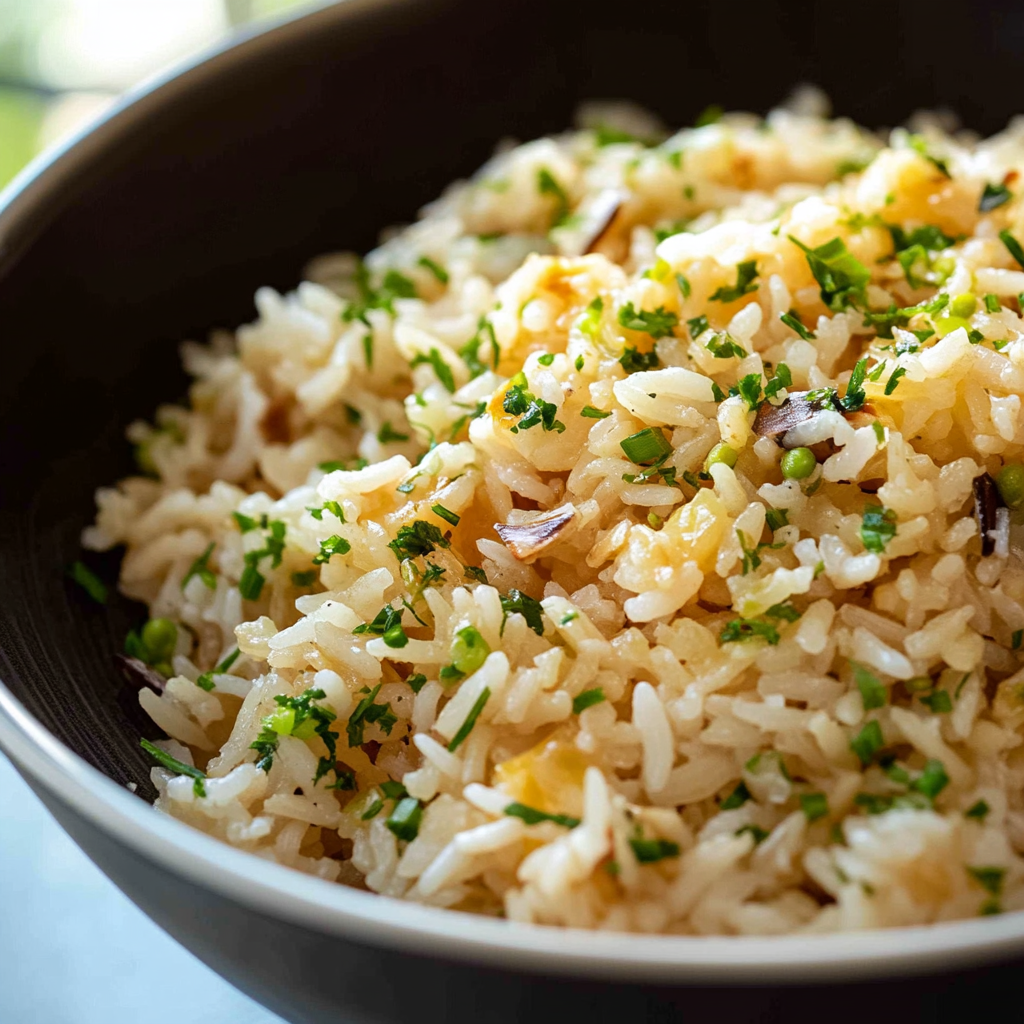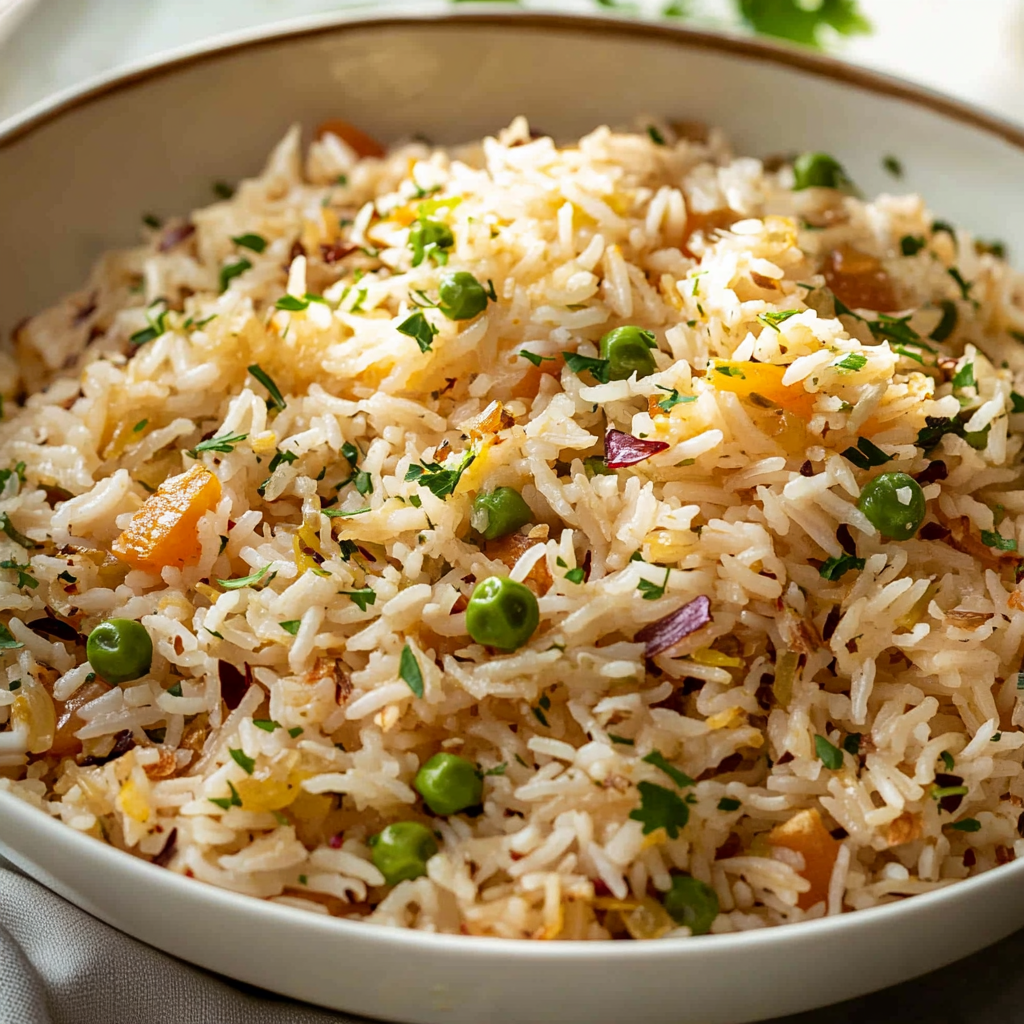Have you ever tasted a dish that transports you to another place with just one bite? Rice pilaf is one such dish, rich in flavors and aromas that create a delightful experience for the senses. The fluffy grains of rice blend perfectly with spices and herbs, making it an ideal accompaniment to any meal.
This rice pilaf recipe brings together simplicity and taste, perfect for family dinners or special occasions. Imagine serving a warm bowl of this fragrant dish alongside your favorite proteins or vegetables. It elevates any meal while being surprisingly easy to prepare. Whether you’re cooking for guests or just enjoying a quiet night in, this dish will impress and satisfy everyone at the table.
Why You’ll Love This rice pilaf
- Versatile Side Dish: Rice pilaf complements various main courses, from grilled chicken to roasted vegetables, making it a go-to option for any meal.
- Easy Preparation: With minimal ingredients and straightforward steps, you can whip up this delightful dish quickly without extensive cooking skills.
- Aromatic Flavors: The combination of spices and herbs creates an enticing aroma that fills your kitchen, enhancing the overall dining experience.
- Nutrient-Rich: Packed with essential nutrients from whole grains and vegetables, this dish is as healthy as it is delicious.

Ingredients for rice pilaf
Here’s what you’ll need to make this delicious dish:
- Long-Grain White Rice: Select high-quality long-grain white rice for the best texture; basmati or jasmine varieties work well too.
- Olive Oil or Butter: Use either olive oil for a healthier option or butter for richer flavor when sautéing the ingredients.
- Onion: A finely chopped onion adds sweetness and depth; yellow onions are commonly used in pilafs.
- Garlic: Fresh minced garlic enhances the flavor profile; avoid using pre-minced options for the best taste.
- Vegetable or Chicken Broth: Opt for low-sodium broth to control salt levels while infusing the rice with flavor.
For added flavor:
- Fresh Herbs (Parsley or Thyme): Chopped fresh herbs brighten the dish; add them towards the end of cooking for maximum freshness.
The full ingredients list, including measurements, is provided in the recipe card directly below.
How to Make rice pilaf
Follow these simple steps to prepare this delicious dish:
Step 1: Prepare Ingredients
Start by measuring out all your ingredients. Rinse the long-grain white rice under cold water until the water runs clear to remove excess starch.
Step 2: Sauté Aromatics
In a large saucepan over medium heat, add olive oil or butter. Once hot, add the chopped onion and sauté until translucent, about 4-5 minutes. Then stir in minced garlic and cook for an additional minute until fragrant.
Step 3: Toast Rice
Add the rinsed rice to the saucepan and stir well to coat each grain with oil. Toast the rice for about 2-3 minutes until it becomes slightly golden.
Step 4: Add Broth
Pour in vegetable or chicken broth along with a pinch of salt. Increase heat until it reaches a boil; then reduce to low heat and cover tightly.
Step 5: Cook Until Fluffy
Allow the rice pilaf to simmer on low heat for about 15-20 minutes or until all liquid is absorbed. Remove from heat but keep covered for an extra five minutes to steam.
Step 6: Fluff and Serve
After resting, uncover and fluff the rice gently with a fork. Stir in fresh herbs before serving warm alongside your favorite main dishes.

Tips and Tricks
Here are some helpful tips to ensure the best results for your dish:
- Rinse Rice Thoroughly: Rinsing prevents clumping by removing excess starch from the grains before cooking.
- Add Nuts or Dried Fruits: For added texture and flavor complexity, consider incorporating toasted almonds or raisins into your pilaf.
- Cover Tightly While Cooking: Keeping a tight lid ensures steam remains trapped inside during cooking for fluffier results.
Mistakes to avoid
- Overcooking the Rice: One of the most common mistakes when preparing rice pilaf is overcooking the rice. This can lead to a mushy texture that detracts from the dish’s overall appeal. To avoid this, always follow the recommended cooking times and ratios. Use a timer to ensure you don’t exceed the cooking time. Fluffing the rice gently with a fork after cooking can also help maintain its texture.
- Neglecting Flavor Development: Failing to develop flavors during the sautéing stage can diminish your rice pilaf’s taste. Always start by sautéing onions or garlic in oil or butter until they’re translucent. This step infuses the rice with rich flavors, enhancing your dish significantly. Don’t rush this process; allowing these ingredients to caramelize slightly will yield a more robust flavor profile.
- Using Insufficient Liquid: Using too little liquid can lead to dry and undercooked rice pilaf. It’s essential to measure your broth or water accurately according to the type of rice you use. A general rule is two parts liquid for every one part of rice, but this may vary slightly based on your recipe. Always check if additional liquid is needed during cooking to achieve that perfect fluffiness.
- Skipping Toasting the Rice: Toasting the rice before adding liquid is an important step that many people overlook. This technique enhances the nutty flavor of your rice pilaf and adds depth to the dish. Heat some oil in your pot and add the uncooked rice, stirring frequently until it turns lightly golden brown. This simple step can elevate your pilaf from ordinary to extraordinary.
- Ignoring Seasoning: Under-seasoned rice pilaf can be bland and uninviting. Always season your dish adequately throughout the cooking process. Start with salt when you add liquid and consider incorporating herbs or spices that match your main ingredients. A pinch of saffron, cumin, or even a bay leaf can transform your pilaf into a flavorful masterpiece.
Serving Suggestions
This rice pilaf is versatile and pairs wonderfully with:
- Grilled Chicken: The light and fluffy texture of rice pilaf complements the smoky flavors of grilled chicken beautifully, making it a perfect side dish for any barbecue or family dinner.
- Vegetable Stir-Fry: Pair your rice pilaf with a colorful vegetable stir-fry for a healthy, vibrant meal. The seasoned rice adds depth to the fresh vegetables and savory sauce.
- Lamb Chops: The richness of lamb chops balances well with the subtle flavor of rice pilaf. This classic combination elevates your dining experience and impresses guests.

FAQs
What is the best type of rice for rice pilaf?
When making rice pilaf, long-grain rice is often preferred because it cooks up fluffy and separate. Basmati or jasmine rice are excellent choices due to their aromatic qualities. They absorb flavors well and create a delightful texture in your pilaf. Avoid short-grain rice, as it tends to be sticky, which is not ideal for this dish. For a unique twist, consider using wild rice or a mix of grains to add depth and nutritional value.
Can I make rice pilaf ahead of time?
Yes, you can prepare rice pilaf ahead of time! Cook the dish according to your recipe and let it cool completely before storing it in an airtight container in the refrigerator. It will stay fresh for up to three days. When ready to serve, reheat gently on the stove or in the microwave, adding a splash of broth or water to restore moisture. This makes it convenient for meal prep or entertaining guests.
How can I enhance the flavor of my rice pilaf?
To enhance the flavor of your rice pilaf, start by sautéing onions and garlic in butter or oil before adding the rice. Toasting the rice for a few minutes enhances its nutty flavor. You can also use broth instead of water for cooking, which infuses additional taste into the grains. Adding spices such as cumin, coriander, or bay leaves can further elevate the dish. Fresh herbs like parsley or cilantro added just before serving provide freshness and brightness.
Is rice pilaf gluten-free?
Rice pilaf is inherently gluten-free as it primarily consists of rice, which does not contain gluten. However, if you are adding any additional ingredients like broth or seasonings, check their labels to ensure they do not contain gluten-based additives. Using pure ingredients ensures that your meal remains safe for those with gluten sensitivities.
Conclusion for rice pilaf
In summary, preparing delicious rice pilaf is straightforward and rewarding. By selecting long-grain varieties such as basmati or jasmine, you will achieve that desired fluffy texture that defines this dish. Elevate your pilaf by incorporating aromatics like onions and garlic while experimenting with herbs and spices to enhance its flavor profile further. This versatile side dish pairs harmoniously with various proteins and vegetables, making it suitable for casual meals or festive gatherings alike. With these tips in mind, you’ll master the art of creating a perfect rice pilaf every time!

Delicious Rice Pilaf
- Total Time: 30 minutes
- Yield: Serves 4
Description
Rice pilaf is a delightful, aromatic dish that transforms simple grains into a flavorful side perfect for any meal. With its fluffy texture and rich seasoning, this pilaf is the ultimate companion to meats, vegetables, or even enjoyed solo as a comforting comfort food. The combination of sautéed onions and garlic, nutty rice, and your choice of broth creates an irresistible aroma that fills the kitchen and delights the senses. Whether you’re hosting a dinner party or enjoying a cozy family meal, this rice pilaf recipe is easy to prepare and sure to impress.
Ingredients
- 1 cup long-grain white rice (basmati or jasmine)
- 2 tablespoons olive oil or butter
- 1 medium onion, finely chopped
- 2 cloves garlic, minced
- 2 cups vegetable or chicken broth
- Fresh herbs (parsley or thyme), optional
Instructions
- Rinse the rice under cold water until clear to remove excess starch.
- In a large saucepan over medium heat, sauté the onion in olive oil or butter until translucent (about 4-5 minutes). Add minced garlic and cook for another minute.
- Stir in the rinsed rice and toast for 2-3 minutes until slightly golden.
- Pour in the broth and season with salt. Bring to a boil, then reduce heat to low and cover.
- Simmer for 15-20 minutes until liquid is absorbed. Let it sit covered for an additional 5 minutes.
- Fluff with a fork and stir in fresh herbs before serving.
- Prep Time: 10 minutes
- Cook Time: 20 minutes
- Category: Side Dish
- Method: Sautéing
- Cuisine: Mediterranean
Nutrition
- Serving Size: 1 cup (200g)
- Calories: 220
- Sugar: 1g
- Sodium: 300mg
- Fat: 8g
- Saturated Fat: 2g
- Unsaturated Fat: 6g
- Trans Fat: 0g
- Carbohydrates: 34g
- Fiber: 2g
- Protein: 4g
- Cholesterol: 0mg

